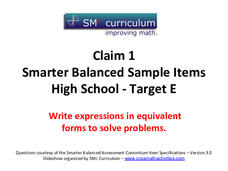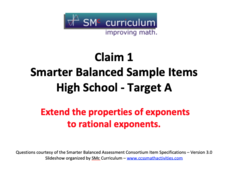ResourcesWeb & Docs
MediaVideo & Audio
CollectionsLessons & Topics
AI Teacher ToolsInstruction & Ideas
newFilter
7 results:
powerpoint math propertiesClear All
CCSS Math Activities
Smarter Balanced Sample Items: High School Math – Target E
Pupils rewrite expressions in equivalent forms to identify key features. They use the vertex and factored forms of quadratic expressions to identify the extrema and intercepts. To finish the installment of the Claim 1 Item Slide Show...
CCSS Math Activities
Smarter Balanced Sample Items: 7th Grade Math – Target C
Pupils may be able to simplify expressions, but do they understand how to simplify an expression? A PowerPoint presentation gives several examples of Smarter Balanced Assessment items that test learners' understanding of the concept....
CCSS Math Activities
Smarter Balanced Sample Items: High School Math – Target B
There are only two options to consider: rational or irrational. Pupils review rational and irrational numbers by answering a set of eight questions provided in a PowerPoint presentation. Part of larger Claim 1 Item Slide Show series, the...
CCSS Math Activities
Smarter Balanced Sample Items: 8th Grade Math – Claim 3
Communication is the key. A dozen sample items require scholars to communicate their reasoning involved in arriving at a solution. The PowerPoint from the Gr. 8 Claim 2 - 4 Item Slide Shows series uses a variety of content to...
CCSS Math Activities
Smarter Balanced Sample Items: High School Math – Target A
Don't get irrational about rational exponents. A PowerPoint presentation highlights the sample high school questions from the Smarter Balanced Assessment Consortium (SBAC) Claim 1 Target A item specifications. As one part of a larger...
Curriculum Corner
Area and Perimeter
Get third graders excited to work find area and perimeter of unit squares, rectangles, and irregular shapes. A 36-page packet comes with task cards, graphic organizers, practice worksheets, printables with squares, exit tickets, and word...
Bowland
Magic Sum Puzzle
Learners discover the magic in mathematics as they solve numerical puzzles involving magic sums. They then make a conjecture as to why no additional examples are possible based on an analysis of the puzzles.








